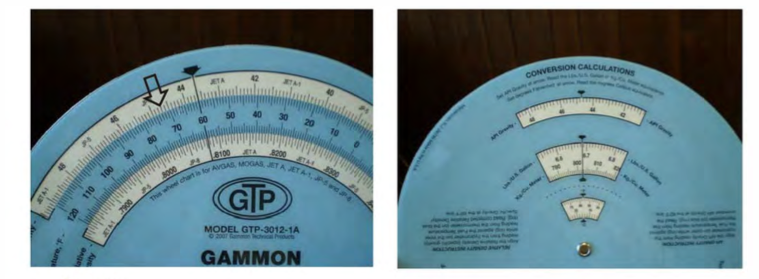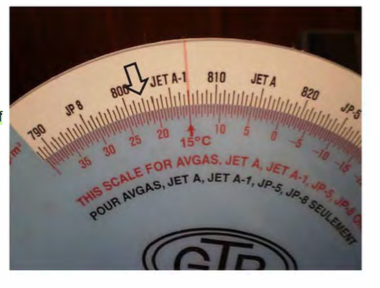
NO. 60 CALCULATING FUEL WEIGHT March 2009
Fuel weight is an important thing to a pilot planning a long flight or a full aircraft. Too much weight and the aircraft cannot safely fly - too little fuel and there may not be enough fuel for a factor of safety if there are unexpected problems.
So we are often asked the actual weight of the fuel we dispense, but it is not simple. Whether the fuel is measured in liters or gallons, the problems are:
1. Fuel that you receive at the airport mixes in with the fuel already in the storage tank. The two fuels will often have a somewhat different density.
2. When that mixture goes into a refueler truck or hydrant system, it mixes with fuel already there with a differnt density.
3. Fuel expands or contracts as fuel temperature increases or decreases. A bucket of fuel will weigh the same at different temperatures, but the volume of the fuel in the bucket changes. You are (almost always) metering the fuel you dispense to the aircraft in volume (gallons or
Liters).
If the pilot really needs an accurate weight, in the USA, use a "pounds per gallon" hydrometer; outside of the USA, use a metric hydrometer (Kg/liter). When you measure the fuel weight, the fuel should be at the same temperature as the fuel that is flowing into the aircraft. The best way to obtain such a sample of fuel is to use a "Visi-Jar" or "Closed Circuit Sampler".
With such a device mounted on your refueler or hydrant cart, you can take a sample of the fuel during fueling, and advise the pilot of the exact weight of the fuel, in pounds per gallon or kilograms per liter, at the true fuel temperature as it goes through the flow meter. This gives the most accurate reading possible. For an example, see:
http:// . gammontech.com/mainframe/catalog/b138.htm
Often on the flight line, such equipment is not available, and the pilot may not require the great accuracy this provides, so there is an alternative using a thermometer and your fuel farm QC records.
If the fuel in the tank that you are using is mostly from a recent delivery (or you have measured the density/gravity of the fuel (after mixing) in that storage tank), we can determine the approximate weight fairly accurately. It requires only one additional bit information, the temperature of the fuel going into the aircraft.
You measure the temperature of the fuel in the truck tank using a dip thermometer, or the temperature of the fuel FLOWING through the system using a threaded metal thermometer. (Note: There MUST be flow past a "screw in" thermometer to get an accurate average temperature.
You can then either use the ASTM Charts (more difficult and expensive) or your "wiz wheel", the GTP-3041-1A (API) or GTP-2727EF (metric) calculator.
API Gravity:
Let's assume the fuel temperature going to the aircraft is 73°F and your corrected fuel gravity (from your fuel farm test records) is 43.6° API.
Here is how it works:
1. Align your corrected API gravity 43.6 with the 60°F mark. (From your records from the fuel receipt. If
you want to be more accurate, do an API hydrometer check on the fuel actually in the tank.)
2. Without moving the wheel, find the temperature for the fuel going to the aircraft, 73°F in this case.
3. Now look at the reading on the API scale that aligns with the 73°F mark, it is about 44.rAPI (see arrow).
4. Now rotate the calculator in your hands so you are looking at the Conversion Calculations (bottom half).
5. Dial in approximately 44.r API (note the API is in 2° degree increments on this scale).
6. Look down to the Lbs./US Gallons scale and you will read just less than 6.69 pounds per gallon.
Round this up 6.7 lb per gallon and give this approximate fuel weigh to the pilot.

Metric Density:
Metric Density is easier because it measures density by weight, but you still must correct the volume for the temperature change. Assume the fuel temperature going to the aircraft is 22° C and the corrected density of the fuel is 807.0 kg/m3 (corrected to 15° C).
1. Align the corrected Metric Density (807.0) with the 15° C mark. (You know the corrected Density from your receipt records or by checking the fuel actually in the storage tank).
2. Without moving the wheel, find your indicated temperature for the fuel going to the aircraft, 22° C in this case.
3. Now look at the reading on the scale that aligns with 22°mark, it is 802.0 kg/m3 (see arrow).
NOTE 1 : If the number comes out between two readings, report the higher weight of the two. Do not try to work out a reading between marks on the scale.
NOTE 2: For more detail on fuel density and gravity, go to Http://www.gammontech.com/main...

